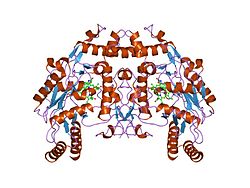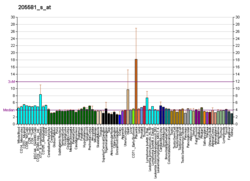Endothelial NOS (eNOS), also known as nitric oxide synthase 3 (NOS3) or constitutive NOS (cNOS), is an enzyme that in humans is encoded by the NOS3 gene located in the 7q35-7q36 region of chromosome 7.[5] This enzyme is one of three isoforms that synthesize nitric oxide (NO), a small gaseous and lipophilic molecule that participates in several biological processes.[6][7] The other isoforms include neuronal nitric oxide synthase (nNOS), which is constitutively expressed in specific neurons of the brain[8] and inducible nitric oxide synthase (iNOS), whose expression is typically induced in inflammatory diseases.[9] eNOS is primarily responsible for the generation of NO in the vascular endothelium,[10] a monolayer of flat cells lining the interior surface of blood vessels, at the interface between circulating blood in the lumen and the remainder of the vessel wall.[11] NO produced by eNOS in the vascular endothelium plays crucial roles in regulating vascular tone, cellular proliferation, leukocyte adhesion, and platelet aggregation.[12] Therefore, a functional eNOS is essential for a healthy cardiovascular system.
- ^ a b c GRCh38: Ensembl release 89: ENSG00000164867 – Ensembl, May 2017
- ^ a b c GRCm38: Ensembl release 89: ENSMUSG00000028978 – Ensembl, May 2017
- ^ "Human PubMed Reference:". National Center for Biotechnology Information, U.S. National Library of Medicine.
- ^ "Mouse PubMed Reference:". National Center for Biotechnology Information, U.S. National Library of Medicine.
- ^ Marsden PA, Schappert KT, Chen HS, Flowers M, Sundell CL, Wilcox JN, Lamas S, Michel T (August 1992). "Molecular cloning and characterization of human endothelial nitric oxide synthase". FEBS Lett. 307 (3): 287–93. doi:10.1016/0014-5793(92)80697-F. PMID 1379542. S2CID 36429463.
- ^ Cockcroft JR (Dec 2005). "Exploring vascular benefits of endothelium-derived nitric oxide". American Journal of Hypertension. 18 (12 Pt 2): 177S–183S. doi:10.1016/j.amjhyper.2005.09.001. PMID 16373196.
- ^ Villanueva C, Giulivi C (Aug 2010). "Subcellular and cellular locations of nitric oxide synthase isoforms as determinants of health and disease". Free Radical Biology & Medicine. 49 (3): 307–16. doi:10.1016/j.freeradbiomed.2010.04.004. PMC 2900489. PMID 20388537.
- ^ Förstermann U, Sessa WC (Apr 2012). "Nitric oxide synthases: regulation and function". European Heart Journal. 33 (7): 829–37, 837a–837d. doi:10.1093/eurheartj/ehr304. PMC 3345541. PMID 21890489.
- ^ Oliveira-Paula GH, Lacchini R, Tanus-Santos JE (Feb 2014). "Inducible nitric oxide synthase as a possible target in hypertension". Current Drug Targets. 15 (2): 164–74. doi:10.2174/13894501113146660227. PMID 24102471.
- ^ Fish JE, Marsden PA (Jan 2006). "Endothelial nitric oxide synthase: insight into cell-specific gene regulation in the vascular endothelium". Cellular and Molecular Life Sciences. 63 (2): 144–62. doi:10.1007/s00018-005-5421-8. PMC 11136399. PMID 16416260. S2CID 22111996.
- ^ Sumpio BE, Riley JT, Dardik A (Dec 2002). "Cells in focus: endothelial cell". The International Journal of Biochemistry & Cell Biology. 34 (12): 1508–12. doi:10.1016/s1357-2725(02)00075-4. PMID 12379270.
- ^ Förstermann U, Münzel T (Apr 2006). "Endothelial nitric oxide synthase in vascular disease: from marvel to menace". Circulation. 113 (13): 1708–14. doi:10.1161/CIRCULATIONAHA.105.602532. PMID 16585403.





